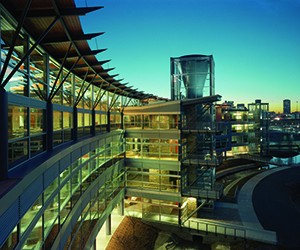With everything from Johnny Cash’s humble boyhood home to a world-class performing arts center, Arkansas is blossoming with new and restored visitor attractions and off-site venues. Whether it’s an elegant 19th century bathhouse in Hot Springs or a riverfront conference center in downtown Little Rock, planners will find no shortage of compelling places that give events a uniquely Arkansas twist.
Robinson Center, Little Rock
The big news in Little Rock these days is the recent unveiling of the renovated and expanded Robinson Center, a performing arts center that made its debut in 1939 as part of a Works Progress Administration initiative.
Over the decades, the Robinson Center has drawn top performers, including the young Elvis Presley, who recorded the first rendition of Hound Dog there in 1956. The renovation, which cost $70.5 million and took 28 months to complete, preserved the center’s stately neoclassical facade and Art Deco architectural features, while making its auditorium equipped to handle major Broadway productions and adding a stunning conference center wing overlooking the Arkansas River.
“This is the most important new tourism product for our city since the Clinton Presidential Center opened in 2004,” said Gretchen Hall, president and CEO of the Little Rock CVB. “The performing arts hall is the crown jewel, but the new conference addition is a whole new face for the building.”
According to Hall, the Robinson Center serves two distinct purposes for Little Rock, giving it a state-of-the art performing arts center as well as a venue for midsize meetings. The conference wing, which connects to the also newly renovated DoubleTree Hotel Little Rock, includes a grand ballroom accommodating up to 533 guests and an adjoining terrace overlooking the Arkansas River. Four smaller meeting rooms open onto the wraparound rooftop Robinson Terrace and its panoramic views of downtown Little Rock and the riverfront.
“Our Statehouse Convention Center hosts larger groups such as state and regional associations, while the Robinson Center gives us a new option for the mid-sized niche,” Hall said. “Plus, the performance hall is available for private events when it’s not in use.”
Clinton Presidential Center, Little Rock
Designed by the same architectural team that renovated the Robinson Center, the Clinton Presidential Center is at the eastern edge of Little Rock in a riverfront area that was once home to derelict warehouses. The multi-tiered, glass-walled structure is now surrounded by rejuvenated wetlands rich with waterfowl and other wildlife. Along with galleries of memorabilia pertaining to the life of the 42nd president, the Platinum LEED structure includes a replica of the Oval Office and event spaces that include the 5,000-square-foot Great Hall, several conference rooms with river and garden views, and the 18,000-square-foot Scholars Garden.
“We do over 400 events a year, everything from small dinners on up to meetings for up to 700 in the Great Hall and adjoining prefunction space,” said Paige Thurmond, catering manager. “We also do events outside, including large concerts and festivals.”
Heifer International, Little Rock
Just a short walk along the riverfront from the Clinton Presidential Center, Heifer International is headquarters for a global organization dedicated to ending world hunger and another important addition to Little Rock’s revitalization.
PageBreak
Accommodating groups of up to 350, the Platinum LEED-certified campus includes a conference center and seminar rooms equipped for live broadcasts and video streaming. The grounds feature a mini farm with a vegetable garden, a barnyard with llamas and goats, and a small pavilion available for events.
Scott Family Amazeum, Bentonville
Bentonville’s newest attraction, the Scott Family Amazeum, is an interactive learning center where children and adults can explore science exhibits, a climbable tree canopy, indoor caves, kinetic movement, art workshops and exhibits pertaining to Ozark history and culture. Along with 50,000 square feet of exhibit, learning and meeting spaces, the museum features teambuilding activities for groups and an acre of outdoor space used for science experiments and private events.
Ozark Bathhouse Cultural Center, Hot Springs
Hot Springs, which has been drawing visitors to its thermal waters since the early 1800s, is filled with listings on the National Register of Historic Places pertaining to its legacy as a spa destination. Among them is the Ozark Bathhouse Cultural Center, which operated as a bathhouse from 1922 to 1977 and recently reopened as a venue for private events and tours. Designed in 1922 in the Spanish Colonial Revival style, the 14,000-square-foot building houses a gallery of works from the Hot Springs National Park’s Artist-in-Residence collection.
Hamp Williams Building, Hot Springs
Another of Hot Springs’ historic gems, the Hamp Williams Building, with its granite facade, exposed beams, ornate iron gates and stonewalled courtyard, is a prime example of 1920s Renaissance Revival architecture. Restored by the Surfas Group in 2009, the former warehouse has indoor and outdoor spaces for events of up to 350 people.
“We have endless possibilities to express your own style, from shabby chic to refined elegance,” said Susie Chandler, event sales manager. “You can reserve our outdoor venue that includes the courtyard and pavilion, or the rustic warehouse area that includes the courtyard and pavilion.”
Arkansas Entertainers Hall of Fame, Pine Bluff
A life-size animatronic figure of Johnny Cash greets visitors at the entrance to the Arkansas Entertainers Hall of Fame in Pine Bluff. The attraction, which includes costumes, musical instruments, books and other memorabilia, chronicles the careers of Cash as well as other Arkansas natives who made their mark in the entertainment world, including Billy Bob Thornton, Glenn Campbell, John Grisham, Levon Helm, Charlie Rich, Jimmy Driftwood, Tracy Lawrence and others.
The Hall of Fame is located inside the Pine Bluff Convention Center, a 90,000-square-foot facility that offers an arena, auditorium/theater, banquet hall, meeting rooms and prefunction areas.
Historic Dyess Colony: Johnny Cash Boyhood Home, Dyess
Recently restored by Arkansas State University as a heritage tourism site, the Dyess Colony was created in 1934 as a New Deal initiative to provide homes for impoverished farm families. The parents of Johnny Cash and their seven children were among those who resettled there. Its surviving buildings include a visitors center and the Dyess Colony Administration Building, which features exhibits relating to the colony’s history, lifestyle of the residents and the impact that growing up in Dyess had on Cash and his music.
isitors can tour the exhibits and then take a shuttle to the nearby Johnny Cash Boyhood Home where the singer lived until his graduation from high school in 1950.
Scheduled for Oct. 19-21 this year, the inaugural Johnny Cash Heritage Festival will be held in Dyess in the cotton fields surrounding the Cash home and in the colony center. Organized by the university and Roseanne Cash, the festival will include concerts by headliners and local performers as well as educational panels, exhibits and crafts.







